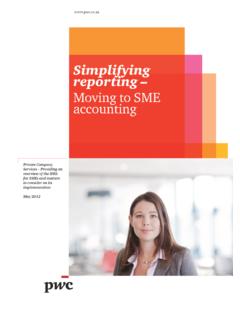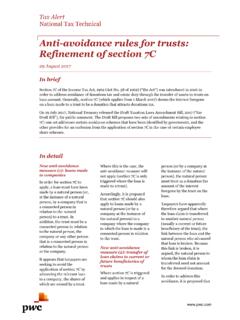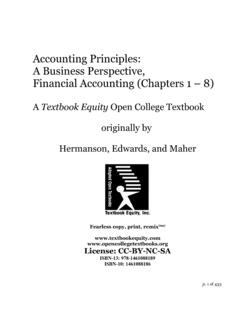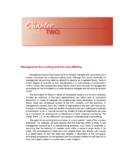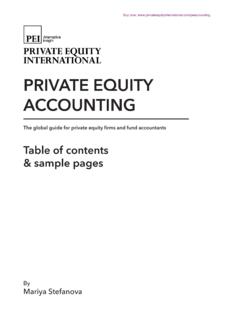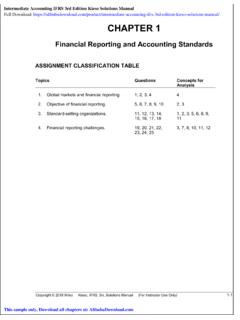Transcription of Understanding the new Companies Act
1 Steering Point No: 1 Understanding the new Companies overview of relevant aspects of the Companies Act, of 2008, and matters to consider regarding its a y 2 011In this issue: Introduction Arrangement of the Act Conflict with other legislation New categorisation of Companies Implications for close corporations Matters for discussion with the auditor Solvency and liquidity Directors and prescribed officers Requirements for directors Loans to directors and inter-company loans Amendment of memorandums of incorporation and shareholder agreements Business rescue Fundamental transactions Transitional provisions How PwC can help you Contacts100 Understanding the new Companies Act Steering Point No: 1 The information contained in this publication is published by PricewaterhouseCoopers (PwC) and is provided for discussion purposes only.
2 As such, it is intended to provide the reader or his/her entity with general information of interest. The information is supplied as is and has not been compiled to meet the reader s or his/her entity s individual requirements. It is the reader s responsibility to satisfy himself or herself that the content meets the individual or his/ her entity s requirements. The information should not be regarded as professional or legal advice or the official opinion of PwC. No action should be taken on the strength of the information without obtaining professional advice. Although PwC takes all reasonable steps to ensure the quality and accuracy of the information, accuracy is not guaranteed. PwC, shall not be liable for any damage, loss or liability of any nature incurred directly or indirectly by whomever and resulting from any cause in connection with the information contained Companies Act, No.
3 71 of 2008 (the Act) significantly changes the landscape of company law in South Africa. The Act was signed by the President on 8 April 2009, but implementation was deferred to accommodate necessary amendments. The Companies Amendment Act, No. 3 of 2011, signed by the President on 20 April 2011 underwent a rigorous process of debate and deliberation by various stakeholders and industry role players during the legislative process. Draft Regulations to the Act were also issued during the latter part of 2010 by the Department of Trade and Industry and the final Companies Regulations 2011 (the Regulations) were published on 20 April effective date of the Act, incorporating the amendments and the Regulations, is 1 May the deliberations, certain sections in the Companies Amendment Act generated considerable attention in the media and discussion in public forums.
4 An overview of these requirements is provided in this publication. PwC will also be publishing a number of other bulletins in the coming months to assist directors and the management of Companies to get to grips with some of the challenges facing most Companies during the transition period and publications will cover:New audit and accounting requirementsBoards of directors and committees, corporate governance and the interplay with King IIID irectors duties, responsibilities and liabilitiesBusiness rescueFundamental transactions, valuations and sharesThe impact of the Act on state-owned entitiesArrangement of the ActThe Act is arranged into nine chapters and five schedules: Chapter 1: Interpretation, Purpose and Application Chapter 2 : Formation, Administration and Dissolution of Companies Chapter 3.
5 Enhanced Accountability and Transparency Chapter 4: Public Offerings of Company Securities Chapter 5: Fundamental Transactions, Takeovers and Offers Chapter 6: Business Rescue and Compromise with Creditors Chapter 7: Remedies and Enforcement Chapter 8: Regulatory Agencies and Administration of the Act Chapter 9: Offences, Miscellaneous Matters and General Provisions Schedule 1: Provisions Concerning Non-Profit Companies Schedule 2: Conversion of Close Corporations to Companies Schedule 3: Amendment of Laws Schedule 4: Legislation to be Enforced by Commission Schedule 5: Transitional ArrangementsThe Regulations should be read in conjunction with the Act, as these provide detail for the practical execution of certain provisions of the Act, including record keeping requirements, dispute resolution, the social and ethics committee, forms, recording of financial information required in accounting records and financial with other legislationSection 5 of the Act determines that if conflict exists between the Act and any other national legislation, both acts apply concurrently to the extent that such an interpretation is possible.
6 In situations of conflict between the Act and any of the following legislation, the latter takes preference: Auditing Profession Act, 2006; Labour Relations Act, 1995; Promotion of Access to Information Act, 2000; Promotion of Administrative Justice Act, 2000; Public Finance Management Act, 1999; Securities Services Act, 2004; Banks Act, there be conflict between the Act and any listing requirements of a securities exchange, the Act prevails. Further consideration should also be given to the interaction between the Act and the legislation governing local government such as the Municipal Systems Act, 2000 and the Municipal Finance Management Act, 1999. 2 Understanding the new Companies Act Steering Point No: 1 New categorisation of companies1 The Act distinguishes between two main categories of Companies , namely profit and non-profit Companies .
7 This categorisation effectively does away with the concepts of widely held and limited interest Companies introduced by the Corporate Laws Amendment Act, Act also introduces the state-owned company, defined as a registered company listed as a public entity in Schedule 2 or 3 of the Public Finance Management Act, 1999 or a company owned by a municipality in terms of the Municipal Systems Act, 2000 and which is otherwise similar to a state-owned enterprise. Except to the extent of ministerial exemption, the provisions of the Act applicable to a public company also apply to a state-owned See Sections 1 and 8 of the Companies Act, 2008 Future publications will explain how the provisions of the Act apply to the different types of Companies , including state-owned Companies , with specific focus on the extended accountability requirements in Chapter 3 of the Act that, inter alia, require the establishment of an audit committee and the appointment of a company secretary and an diagram below shows the different types of Companies that may be formed in terms of the for close corporations2As of 1 May 2011, no further registrations of close corporations is possible.
8 But existing close corporations may convert to Companies by filing, amongst other required documents, a notice of conversion. Conversion is, however, not compulsory and close corporations will continue to exist until deregistration or dissolution in terms of the Close Corporations Act, 1984. Close corporations will be treated as private Companies and are subject to the same audit requirements as private See Amendment of Laws in Schedule 3 and Transitional Provisions in Schedule 54 Understanding the new Companies Act Steering Point No: 1 Matters for discussion with the auditorAccounting records and financial statements3 The Act requires Companies to keep accurate and complete accounting records in one of the official languages of the Republic and in the prescribed format necessary to enable the company to satisfy its obligations in terms of the Act or any other law with respect to the preparation of financial a company provides any financial statements to any person for any reason, these statements must satisfy the financial reporting standards as to form and content if any such standards are prescribed and amongst other requirements, must present fairly the state of affairs and business of the company.
9 The statements must also prominently indicate whether they have or have not been audited or independently reviewed in compliance with any applicable requirements of the and independent reviews4 The Act requires that an auditor be appointed for both public and state-owned Companies and that all such Companies be audited annually. Private Companies , personal liability Companies and non-profit Companies are subject to audit where provided for: in the memorandum of incorporation; or by way of a shareholders resolution; or in terms of a board decision; or by the Regulations to the minister may prescribe by way of regulation the categories of any profit or non-profit company to be audited. The Regulations introduced a public interest score whereby a private, personal liability or non-profit company that achieves a score of 350 or more is subject to audit and those below 350 are subject to an independent review, subject to the requirements and the exemptions contained in Section 30.
10 3 See Sections 27, 28 and 29 read with the Regulations4 See Section 30 and Chapter 3 read with the RegulationsThe public interest score is calculated according to the average number of employees in the company, the value of third-party liabilities, the turnover of the company and the number of persons who directly or indirectly have a beneficial interest in any of the company s issued securities. The next publication in this series will focus on the specific requirements relating to audit and rotation5 The provisions regarding auditor rotation apply from the effective date of the Act .The same individual may not serve as the auditor or designated auditor of a company for more than five consecutive financial years. The rotation requirement in section 90 should be considered against the background of other regulatory requirements contained in the independence requirements for auditors such as the Independent Regulatory Board for Auditors Code of Professional Conduct and the requirements of the King Code of Governance for South Africa 2009 (King III).

